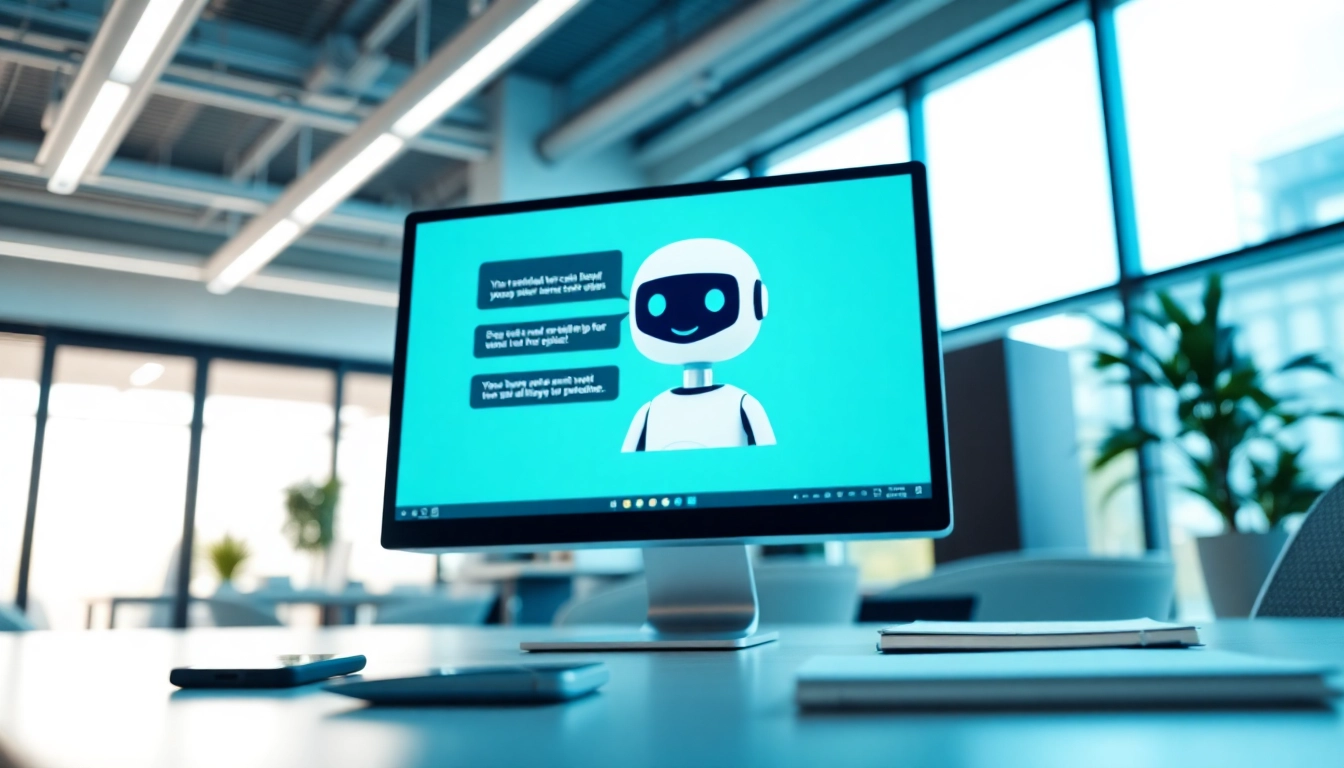Understanding AI Bots for Websites
What is an AI Bot?
At its core, an AI bot for websites is an automated software agent designed to facilitate communication with users through conversational interfaces. These bots utilize artificial intelligence to simulate human-like dialogue, with the ability to understand and respond to queries in a natural language format. As technology has advanced, modern AI bots can analyze context, learn from interactions, and provide personalized responses that enhance user satisfaction and engagement.
Key Features of AI Bots
AI bots come equipped with several essential features that enable them to perform effectively in various scenarios. Some of these features include:
- Natural Language Processing (NLP): Enables the bot to understand and interpret user input accurately, allowing for more fluid conversations.
- Machine Learning: Facilitates the bot’s ability to learn from previous interactions, continually improving its responses over time.
- Multichannel Support: Allows the bot to operate across multiple platforms, such as websites, mobile applications, and social media, ensuring consistent user engagement.
- Integration Capabilities: Enables the bot to connect with existing business systems, such as CRM software, to retrieve and update relevant information.
- User Personalization: Provides tailored experiences by using data about users to give more relevant responses and recommendations.
How AI Bots Enhance User Experience
AI bots significantly enhance user experience by providing immediate assistance, reducing wait times, and offering 24/7 service. When users visit a website, they often seek quick answers to their queries. AI bots can alleviate frustration by delivering instant information, guiding users through processes, or resolving issues without human intervention. This immediacy contributes to higher user satisfaction and loyalty, as visitors feel valued and supported.
Benefits of Implementing AI Bots
Improving Customer Support with AI Bots
One of the primary benefits of deploying an AI bot on your website is the transformation of customer support. Traditional customer service models often rely on human agents who may be overwhelmed with queries, resulting in long response times. In contrast, AI bots can efficiently handle thousands of inquiries simultaneously. Furthermore, they can be programmed to respond to common questions, freeing human agents to tackle more complex issues. This model not only improves response times but also allows businesses to allocate resources more effectively.
Increasing Conversion Rates through Engagement
AI bots can drive increased conversion rates by engaging users at critical decision-making windows. For example, through proactive messaging, bots can reach out to visitors who exhibit behavior indicative of interest, such as spending time on a product page. By answering questions related to the product, offering promotions, or nudging users towards completing their purchases, AI bots can effectively convert hesitant visitors into loyal customers. Utilizing AI bots for targeted marketing efforts can thus serve as a strong catalyst for sales growth.
Streamlining Business Operations with Automation
In addition to enhancing customer interactions, AI bots play a crucial role in streamlining business operations. They can automate repetitive tasks such as scheduling appointments, processing transactions, or sending reminders, minimizing the risk of human error and freeing up time for employees to focus on higher-value activities. Automation through AI bots can lead to significant operational efficiencies, ultimately improving productivity and reducing costs for businesses.
Choosing the Right AI Bot for Your Website
Criteria for Selection
Selecting the right AI bot for your website requires careful consideration of various factors. Here are key criteria to evaluate:
- Purpose: Clearly define what you want the AI bot to accomplish—whether it’s improving customer support, optimizing sales, or facilitating lead generation.
- Technology: Research the underlying technology that powers the bot. Ensure it uses robust NLP and ML capabilities to enhance user interactions.
- Customization: Look for bots that offer customization options to tailor the conversational flows and responses to match your brand’s tone and messaging.
- Integration: Assess the bot’s ability to integrate seamlessly with your existing systems and platforms, such as CRM systems or marketing automation tools.
- Analytics Capabilities: Ensure the AI bot comes with robust analytics features that allow you to measure performance, user engagement, and areas for improvement.
Integrating AI Bots with Existing Systems
To maximize the potential of an AI bot, it’s essential to integrate it with your current systems. This integration can range from linking the bot to customer relationship management (CRM) software to ensuring it accesses real-time data from your inventory management system. The goal of integration is to create a seamless user experience where the bot can provide accurate, timely information while also logging interactions for future reference. Properly integrated bots can enhance the effectiveness of customer support, sales processes, and overall user satisfaction.
Case Studies: Successful Implementations
Examining successful implementations of AI bots provides valuable insights into their potential. For instance, a leading e-commerce platform deployed an AI bot to assist users in browsing products and answering queries. As a result, they experienced a 25% increase in sales and significantly reduced cart abandonment rates. Additionally, a financial services company implemented a chatbot on their website to help users understand complex financial products, which led to improved customer engagement and a 40% reduction in call center workloads. Such case studies demonstrate not only the versatility of AI bots but also the tangible benefits they bring to diverse sectors.
Best Practices for AI Bot Deployment
Creating Effective Chatbot Dialogues
Crafting effective dialogues for your AI bot is crucial for fostering meaningful interactions. Start by understanding user intents and typical queries, then structure conversations to guide users toward their desired information. Keeping dialogues simple, conversational, and personalized can greatly enhance user experience. Additionally, using diverse response formats – such as quick reply buttons, images, and videos – can make interactions more engaging and informative.
Monitoring and Analyzing Performance
Regularly monitoring your AI bot’s performance is essential to maintain its effectiveness. Utilize analytics tools to track metrics such as user engagement, response accuracy, and conversation completion rates. By analyzing these indicators, you can identify areas for improvement and assess whether the AI bot meets your initial objectives. Continuous performance monitoring helps ensure your AI bot evolves alongside user needs and maintains high levels of engagement and satisfaction.
Iterating Based on User Feedback
Gathering user feedback is an invaluable step in the iterative process of refining your AI bot. Through surveys, ratings, or direct queries asking users how satisfied they were with their interaction, you can gain insights into their needs and pain points. Use this feedback to fine-tune dialogues, update responses, or enhance functionalities. Iteration based on user feedback ensures the bot remains relevant, user-friendly, and effective in fulfilling its intended purpose.
The Future of AI Bots and Digital Communication
Emerging Trends in AI Technology
The landscape of AI technology is continuously evolving, with several emerging trends poised to reshape the future of AI bots. Advancements in natural language understanding and machine learning will facilitate even more sophisticated bots capable of handling complex queries with ease. Additionally, growing adoption of voice-enabled interfaces and multimodal interactions (e.g., combining text, voice, images) will broaden the ways users engage with AI bots. Furthermore, the integration of AI bots with Internet of Things (IoT) devices may lead to innovative applications, significantly enhancing the user experience.
Preparing for the Next Generation of Chatbots
As AI technology continues to develop, businesses must prepare for the next generation of chatbots. This preparation includes staying informed about new technologies, investing in training and resources, and being agile enough to adapt to changing user expectations. Businesses should also prioritize building strong partnerships with AI technology providers to ensure they remain at the cutting edge of innovations and can leverage the best tools available in an increasingly competitive digital landscape.
Innovative Use Cases Beyond Customer Service
While AI bots are primarily recognized for their role in customer service, their applications extend far beyond. Industries are exploring innovative use cases such as using AI bots in recruitment processes to screen candidates, in healthcare settings to provide patients with preventive care tips, and in education to offer personalized learning experiences. These diverse applications highlight the versatility of AI bots and their potential to innovate various sectors by enhancing efficiency, providing deeper insights, and improving user engagement.









